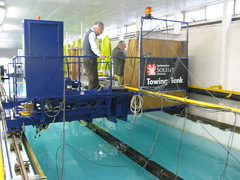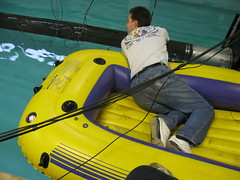




From their website :
"The Anaconda concept is shown schematically in Figure 2. A running bulge wave is generated by squeezing the water-filled rubber tube. The bulge wave travels at a speed that is determined by the geometry and material properties of the tube. Anaconda is designed so that its bulge wave speed is close to the speed of the external water waves above. In this resonance condition the bulges grow as they travel along the tube, gathering wave energy. Inside the tube, the bulge waves are accompanied by a periodically reversing flow. Localised squeezing and enlarging effects permit energy to be extracted indirectly with a Power Take-Off (PTO). One way of extracting power from Anaconda is to use a pair of duck-bill valves to convert this power into a rectified flow past a turbine between high and low pressure reservoirs. The animation below shows an impression of the Anaconda wave energy converter at full scale."
http://www.youtube.com/watch?v=kJF1Q-rOSm4
http://www.dailymotion.com/video/xb1xsj_anaconda-wave-energy-converter-towi_tech
http://vimeo.com/7465206
original file 197MB: http://international-ocean-station.org/download/20091105anaconda-towing-tank.mov
As a designer I was asked to give feedback and perhaps find ways of collaborating, imagining applications, scenario of usage, alternative designs... beyond the production of an "artist impression"!
The video ends by the remark of Prof. Farley :
"Trouble is: the energy you get out over the year depends on the average wave, which is maybe not very big, but sometimes there is a big wave that could break your equipment. The equipment has to support, resist the huge wave, that's expensive, but the energy you get out is for the average wave, and this is the main difficulty. There have been very many wave energy machine that has been built, and they've been brocken."So I was interested in this vulnerability in particular ... and other problems, with a serie of rough ideas of how these could be solved :

- Anchoring : Many floating installations break at their anchoring point or because the anchoring causes too much stress on the structure of the floating element itself. I would like to see how much efficiency we loose by not being anchored or much less firmly.
- Solid parts vulnerability : The main advantage of the Anaconda is that it does not have solid parts so far. The energy transforming and distribution system should be developed in order to be flexible too. I will try to design toward most flexibility.
- Single source of energy : Like any other renewable energy, waves are not providing a stable resource of energy : users that need to be ensured of a steady energy will not invest in this technology. I suggest we couple the Anaconda with other renewable energy generating technologies (sun, wind...).
- Large scale : I am more interested of smaller scale application because: could be mobile applications, it is cheaper to develop more accessible to modest people, less dangerous as infrastructure at sea for boats.
- Off grid : This goes in the same idea as not anchoring the module : What if an anaconda was not linked to the main grid and had its own purpose, for example producing energy for a petrol platform, producing electricity for a data wireless mesh network, we would save of the pollution and work caused by the infrastructure.
- Maintenance : I have been thinking maintenance on such a huge structure is not going to be easyas it moves severly...
- Electricity collection and flogging : The bottom of the anaconda is the part that moves the most and whips the most violently. We cant hope to pull the collector's cable from the bottom, the movements are too violent, any conductive cable would shatter quickly...
What I would like to investigate:
- Animals locomotion using techniques similar to bulging

http://en.wikipedia.org/wiki/Terrestrial_locomotion#Limbless_locomotion
And how animals movement teach us what's the most energy efficient way of moving.
- Blob robotic, or how we can transform non-linear forces (waves) with robotics
How does a complex structure copes with extreme distortions and how to make the most out of it ?
- Nano-technology

Best way to avoid solid part is making the anaconda out of a fabric that collects energy while in movement. Picture above : Each microfibre consists of a Kevlar stalk and a series of zinc-oxide nanowire bristles. In each pair of fibres one is coated in gold (yellow). These scrub the uncoated fibres (green) producing electricity.
http://news.bbc.co.uk/1/hi/technology/7241040.stm
http://www.news.com.au/technology/story/0,25642,23211409-5014108,00.html
http://www.nanoscience.gatech.edu/zlwang/wang.html
http://www.sciencedaily.com/releases/2006/08/060820192933.htm
it would also be a very elegant way of linking the very big 200m long anaconda and the nano-scaled actual technology to collect electricity on the whole surface.
- Anti-explosion Mesh / exoskeleton


that could also possibly act as
- Bulge amplifying mesh


- use of semi rigid materials / different shapes
spiral (amplification of bulge with centrigugal force + creation on internal vortex for resonant bulge coming back in the tube.
My direction:
I think I want to build quick prototypes to investigate my preferred questions toward specific applications :
- Non anchored systems
- mobile applications a at little scale
- exoskeleton / mesh tubes to limit/protect or normalize the inflation of the flexible bulging tube to avoid explosion but maximize/normalize the energy production
- coupling with other renewable technologies (like the Open_Sailing Energy_Animal)
More informations :
http://www.energy.soton.ac.uk/wave/anaconda.html
http://www.bulgewave.com/bulge.html
http://www.checkmateuk.com/seaenergy/
http://www.epsrc.ac.uk
http://www.nesta.org.uk
http://www.solent.ac.uk
http://www.interaction.rca.ac.uk
http://www.cesarharada.com
http://www.opensailing.net
No comments:
Post a Comment
Please leave us comments, ideas, remarks, inspirations ...